Sunday, 19 June 2011: Saint-Étienne with the ghost of the Maître Kanter
Written19 July 2011
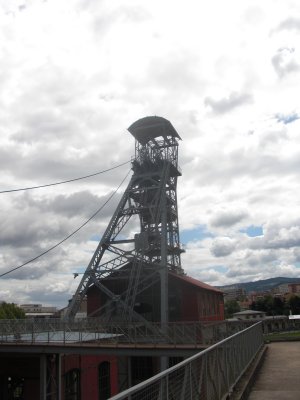
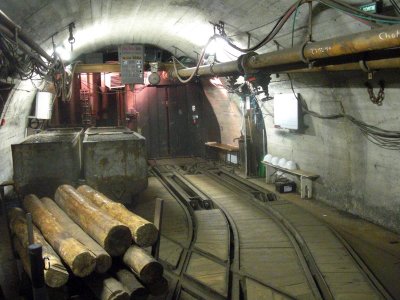 For Sunday, we had planned two of the highlights of our visit to Saint-Étienne, the museum of mines and the city museum. My stomach was a little unsettled at breakfast time, but I took my usual approach to the problem—eat something—and that seemed to help.
For Sunday, we had planned two of the highlights of our visit to Saint-Étienne, the museum of mines and the city museum. My stomach was a little unsettled at breakfast time, but I took my usual approach to the problem—eat something—and that seemed to help.
We got a fairly early start and walked back to the tourist office to acquire day passes to the tram. We were also able to catch the tram there, just outside, and rode it most of the way to the Museum of Mining, which is right there in town, an easy walk from the town hall, at the pithead of the old Couriot coal mine. We could see it from quite a distance, as the site is marked, as apparently were all coal mines of the era, by this tower, called a "chevalement," directly over the pit. I never got straight whether its main purpose was hoisting the coal out or hoisting the miners in and out—perhaps both.
When we got there, we weren't entirely sure we were in the right place, though, as it looked just like the abandonned coal mine that it is—dilapidated buildings, a large area of waste ground, and no sign of life at all. Only when we had walked about halfway around it, looking for the entrance, did we find a sign pointing us to the ticket office and gift shop.
While we waited for the guided tour, we watched a slide show about the history of coal mining in the area, which used to be the major source of coal (which, at the time, meant major source of all energy) from France and other nearby countries. The last of the mines was closed down within living memory, unable to complete with cheap imported coal and other sources of energy.
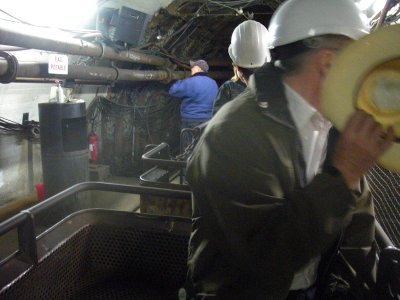
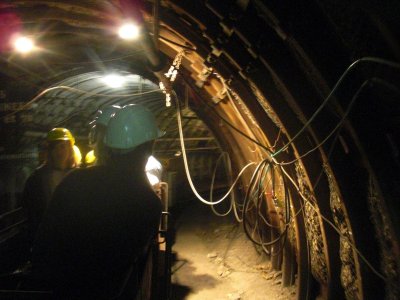 At the appointed hour, we and about 20 other people met the guide, as arranged, in the courtyard. He led us through the ramshackle buildings to the pithead (the equipment all seems to work, but absolutely nothing has been done to spruce things up), ensured that each of us chose a hardhat from the racks and adjusted it to fit (one little old lady was so small that she had to select a yellow helmet from the childrens' section; the rest of us got white ones), and took us down in an open cage elevator into the mine. The photo to the right of the tower shows that chamber into which we emerged. The red wall in the background is the elevator door we came out of. Most of my photos seem to have caught sections of wall that are now sheathed in metal or concrete, but farther along the tunnels we came to areas still shored up with timber. Every mine had a large crew of carpenters who did nothing else.
At the appointed hour, we and about 20 other people met the guide, as arranged, in the courtyard. He led us through the ramshackle buildings to the pithead (the equipment all seems to work, but absolutely nothing has been done to spruce things up), ensured that each of us chose a hardhat from the racks and adjusted it to fit (one little old lady was so small that she had to select a yellow helmet from the childrens' section; the rest of us got white ones), and took us down in an open cage elevator into the mine. The photo to the right of the tower shows that chamber into which we emerged. The red wall in the background is the elevator door we came out of. Most of my photos seem to have caught sections of wall that are now sheathed in metal or concrete, but farther along the tunnels we came to areas still shored up with timber. Every mine had a large crew of carpenters who did nothing else.
A few yards from the elevator, we boarded authentic metal train cars and rode them perhaps a hundred yards along the tunnel. David isn't actually trying to avoid paparazzi—he's just trying to keep his panama hat from getting dirty or snagging on any of the equipment along the sides of the tunnel. After dismounting from the train, we continued the tour on foot. Part of the narration was provided live by the guide, but the tunnels were also furnished with TV monitors every few yards, each showing an explanatory video appropriate to the features we were seeing—the various techniques used at the coal face itself and how they evolved over the years, progressive improvements in dust control and ventilation, etc..

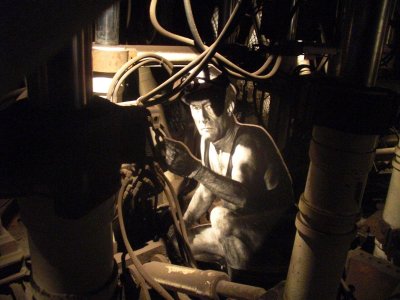 The tunnels were "populated" with highly effective black and white cardboard cutouts of the people and horses who worked there. On the right, for example, that is the very machinery that the miner was working on when he was photographed; it's real, but he's a cardboard cutout. The horse is also cardboard, although he's an image of real horse that did actually pass its entire adult life in the mine. Getting a horse into or out of a mine was a very big deal— it couldn't fit in the elevator standing up, so it was slung in some sort of harness (the guide for that portion of the tour was not very clear in her description of the position in which they had to be lowered, but the horses had to be blindfolded so they wouldn't freak out during the process)—so once one was down there, it was normally there for life (although some were occasionally hoisted out if they needed medical attention). Contrary to popular legend, we were assured, the horses did not go blind—if they ever were hoisted out, they still had to be blindfolded—but most live long and healthy lives entirely underground. One, it was said, came to know his job so well that he knew exactly how many trips down the tunnel and back made up a shift and reacted with surprise if asked to do less and great indignation if asked to do more. We visited the underground stable, which still smelled faintly like a stable (I wonder whether the small has really lasted or whether they bring in "used" straw just to maintain that illusion).
The tunnels were "populated" with highly effective black and white cardboard cutouts of the people and horses who worked there. On the right, for example, that is the very machinery that the miner was working on when he was photographed; it's real, but he's a cardboard cutout. The horse is also cardboard, although he's an image of real horse that did actually pass its entire adult life in the mine. Getting a horse into or out of a mine was a very big deal— it couldn't fit in the elevator standing up, so it was slung in some sort of harness (the guide for that portion of the tour was not very clear in her description of the position in which they had to be lowered, but the horses had to be blindfolded so they wouldn't freak out during the process)—so once one was down there, it was normally there for life (although some were occasionally hoisted out if they needed medical attention). Contrary to popular legend, we were assured, the horses did not go blind—if they ever were hoisted out, they still had to be blindfolded—but most live long and healthy lives entirely underground. One, it was said, came to know his job so well that he knew exactly how many trips down the tunnel and back made up a shift and reacted with surprise if asked to do less and great indignation if asked to do more. We visited the underground stable, which still smelled faintly like a stable (I wonder whether the small has really lasted or whether they bring in "used" straw just to maintain that illusion).
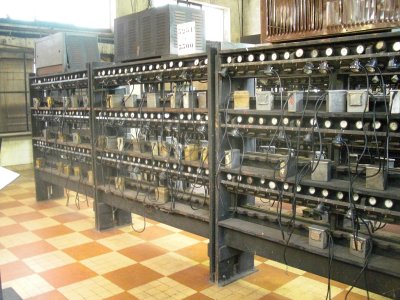
 After the underground tour, we visited other areas involved in the operation of the mine. At the left is a photo of the lamp room—each miner checked out a freshly charged lamp at the beginning of his shift and turned it in at the end to be charged (or, in the old days, refilled with oil) overnight. Each miner also carried a numbered token which he hung up in a particular place as he entered the mine and retrieved when he came back out, as a safeguard against anyone's being accidentally left behind in the pit.
After the underground tour, we visited other areas involved in the operation of the mine. At the left is a photo of the lamp room—each miner checked out a freshly charged lamp at the beginning of his shift and turned it in at the end to be charged (or, in the old days, refilled with oil) overnight. Each miner also carried a numbered token which he hung up in a particular place as he entered the mine and retrieved when he came back out, as a safeguard against anyone's being accidentally left behind in the pit.
At the right are the showers, where the miners could scrub the grime off before going home for the day. Apparently that was a fairly late innovation. For generations, the miners had to go home and clean up there.

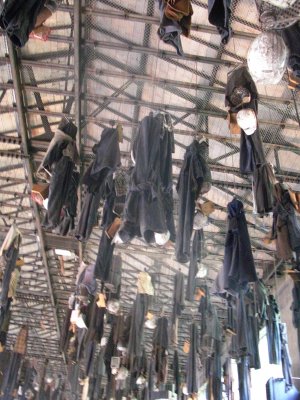 Finally, we visited the room everyone else on the tour had heard about (apparently it's a prominent part of the saga of coal mining in France) and waited to see, " la salle des pendus" ("the hall of hanged men"). To give the miners a certain amount of security against having their equipment or personal belongings pilfered by others without devoting the space and materials needed to build actual lockers, the mines hit on this system. Each miner was asigned a pulley with a wire basket for small items and various hooks for clothing, hard hats, shoes, etc. While on duty, he ran his street clothes up to the ceiling and tied off the rope to a cleat below. At the end of the day, he lowered his clothes to change into them and ran his work clothes, boots, and whatnot up in their place. Different people had devised different security measures, like replacing part of the rope with chain and padlocking it to the cleat. (Robert Hessler's lab at Scripps Institution of Oceanography, where David did his graduate work, used a similar system. They had no room on the floor for bicycles, so bike riders hung their bikes from two hooks mounted on a short section of board, ran them up on pulleys to the 14-foot ceilings over their desks, and tied them off to table legs.)
Finally, we visited the room everyone else on the tour had heard about (apparently it's a prominent part of the saga of coal mining in France) and waited to see, " la salle des pendus" ("the hall of hanged men"). To give the miners a certain amount of security against having their equipment or personal belongings pilfered by others without devoting the space and materials needed to build actual lockers, the mines hit on this system. Each miner was asigned a pulley with a wire basket for small items and various hooks for clothing, hard hats, shoes, etc. While on duty, he ran his street clothes up to the ceiling and tied off the rope to a cleat below. At the end of the day, he lowered his clothes to change into them and ran his work clothes, boots, and whatnot up in their place. Different people had devised different security measures, like replacing part of the rope with chain and padlocking it to the cleat. (Robert Hessler's lab at Scripps Institution of Oceanography, where David did his graduate work, used a similar system. They had no room on the floor for bicycles, so bike riders hung their bikes from two hooks mounted on a short section of board, ran them up on pulleys to the 14-foot ceilings over their desks, and tied them off to table legs.)
By the time we finished the tour, it was time for lunch, but as we rode the tram back toward the hotel, David complained that his stomach was upset and said he didn't want lunch. Why didn't I just go out by myself and bring him back something simple. I admitted that my stomach had been pretty uneasy all morning, too. Our thoughts immediately turned to the steak tartare at the Maître Kanter, but as I pointed out, we'd had that for lunch on the previous day. Salmonella would have made itself known the evening before. Only the following day did David hear on television that part of Europe's E. coli outbreak had been traced to ground beef! Drat. If we had had our steak tartare at some little hole-in-the-wall place, it would have been impeccably fresh and hand chopped to order, and we would have been fine. Only in a chain would we have been served "industrial" ground beef mixed and seasoned in batches well in advance.
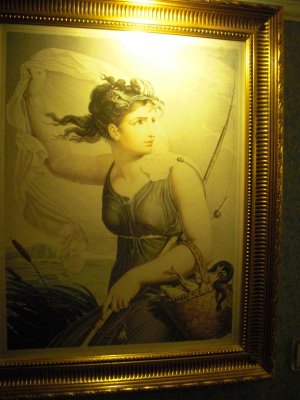
 In the end, I just walked down to the train station and got us a train-trip type picnic—baguette sandwiches, pastry for me, and cookies for David—which we ate in the room. The train station is famous for the colored tiles with which its exterior is trimmed, and it also featured a couple of modern pieces of monumental art. The best, I thought, was a tree with rectilinear metal trunk and branches hung with large flat plastic oak leaves in what were supposed to be autumn colors. Okay, but not as cool as the flower tree in Lyon.
In the end, I just walked down to the train station and got us a train-trip type picnic—baguette sandwiches, pastry for me, and cookies for David—which we ate in the room. The train station is famous for the colored tiles with which its exterior is trimmed, and it also featured a couple of modern pieces of monumental art. The best, I thought, was a tree with rectilinear metal trunk and branches hung with large flat plastic oak leaves in what were supposed to be autumn colors. Okay, but not as cool as the flower tree in Lyon.
Outside the train station, I paused to take a photo of a bust of Marc Seguin (1786-1875, inventor of the "chaudiere tubulaire," the tubular boiler, featured on the first railroad line in France, one end of which was at Saint-Étienne). One of a group of idle young men hanging around the plaza then gave me the closest I ever got to backchat from a French youth—he said, "How come you're taking his photo and not mine?" and struck a pose. But when I said, "Of course! You're right! Smile!" and turned the camera on him, he shied away sheepishly, saying, "I was only kidding, really."
I also took the opportunity to get the two shots above. On the left is a painting that hung in the hallway outside our room. Next to it was the standard scene of such a neo-classical lady with bow and arrows, hounds and stag. Very typical. But somehow this one, with the cane fishing pole (complete with cork) and basket of fish (including an eel) struck me as singularly incongruous. Much more "classical" if she'd been carrying a net.
At the right is one of two murals (actually thin sheets of painted plywood appliquéed to the side of the building) that adorned the front of our hotel. I have no idea what they were a propos of. The other one also featured a woman standing on top of a man but in a different pose. Bizarre.
After lunch, although my own stomach remained somewhat unsettled, I was particularly anxious to get to the city museum in time for the Sunday-afternoon guided tour, but David still felt crummy and wanted to stay in the room, so I set off alone. The tram took longer than I had planned, and I had kind of an uphill hike at the other end, but I missed only about the first five minutes of the tour. A docent escorted me through the room they'd already done to join the group.

 The museum houses three collections, each representing one of Saint-Étienne's claims to fame: manufacture of weapons, manufacture of bicycles, and manufacture of ribbons and braid. (The fourth, mining, and the fifth and most recent, design, are covered elsewhere.) The guide tour started with the museum of weapons. The first exhibits were of the usual swords and armor (what the French call "armes blanches," i.e., "white arms", as opposed to "armes à feu," i.e., firearms), not made locally but exhibited as a sort of historical lead-in to the firearms, for which the city was long famous. They have hundreds—a few canons, mortars, and whatnot, but mostly hand-held, one-person long guns and some hand guns. The collection was arranged to show the transitions from match lock to flint lock to cap-and-hammer to fire pin and from free-hand muzzle loading to cartridges to breech loading. Saint-Étienne was famous for firearms from their earliest invention, in the days before interchangeable parts, when every gun was individually hand made. For a long time, an enormous factory, up at the northern end of the tramway, where we never got, turned out rifles by the thousands for the military. Today, the best hand-made hunting guns are still made there, by specialists in small workshops. Some of those in the collection, both old and modern, are beautifully engraved and carved.
The museum houses three collections, each representing one of Saint-Étienne's claims to fame: manufacture of weapons, manufacture of bicycles, and manufacture of ribbons and braid. (The fourth, mining, and the fifth and most recent, design, are covered elsewhere.) The guide tour started with the museum of weapons. The first exhibits were of the usual swords and armor (what the French call "armes blanches," i.e., "white arms", as opposed to "armes à feu," i.e., firearms), not made locally but exhibited as a sort of historical lead-in to the firearms, for which the city was long famous. They have hundreds—a few canons, mortars, and whatnot, but mostly hand-held, one-person long guns and some hand guns. The collection was arranged to show the transitions from match lock to flint lock to cap-and-hammer to fire pin and from free-hand muzzle loading to cartridges to breech loading. Saint-Étienne was famous for firearms from their earliest invention, in the days before interchangeable parts, when every gun was individually hand made. For a long time, an enormous factory, up at the northern end of the tramway, where we never got, turned out rifles by the thousands for the military. Today, the best hand-made hunting guns are still made there, by specialists in small workshops. Some of those in the collection, both old and modern, are beautifully engraved and carved.
My photos of the guns didn't come out very well. The glare off the glass cases was bad, and many of the cases were double-sided, so you could see right through them, and I had no way to get any of the contents against a plain background. At the left, though, was one I could show clearly. It's six or eight feet long, is by Philippe Perrin, and is entitled (as you might hypothesize) "Gun." I don't think it's a working model. At the right is a a late-19th-century depiction of the arms factory, called the "Manufacture Française d'Armes," later shortened to "ManuFrance." A special exhibit on just that factory and its long history was in progress, but I didn't have time to visit it. It's no longer in operation, and its site is now the home of the "Cité du Design" ("cité" is cognate with "city," but it actually means something more like "campus"). If we ever get back to the area, that would be worth a visit. Saint-Étienne is now apparently a major center for design (the French have borrowed the English word and even pronounce it more or less as an American would; once, years ago, Françoise's ex-husband Richard had been explaining to us for half an hour the differences among Art Nouveau, Art Deco, and "moe-dairn-STEEL" before I twigged that that last is written "modern style").
But what does a busy arms factory do when the war is over and the army suddenly needs only hundreds of new guns a year? It seems that the answer is obvious to manufacturers the world over—it turns to building something else that uses all the same tools and equipment. Idle arms factories build bicycles. Saint-Étienne is therefore also widely recognized as an epicenter of bicycle design and construction; hence the museum's second major collection.
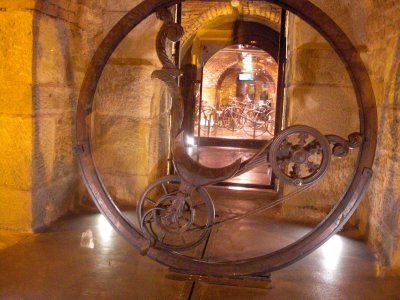
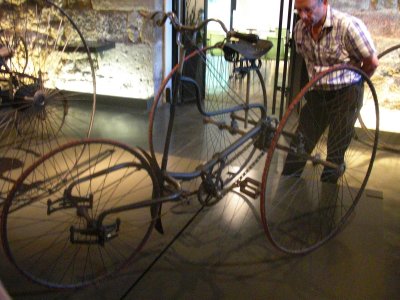 The bicycle section has an amazing variety of early and modern bicycles and their precursers, from early wooden "velocepedes," like modern foot-propelled scooters but with larger wheels and a saddle (you straddled them like bicycles but pushed yourself along with your feet) to the classic "penny-farthing" with the huge front and tiny rear wheels (unsafe at any speed), through the realization that use of a chain meant the pedals didn't have to be on the actual wheel hub and that gears could give you mechanical advantage without a huge wheel, to the earliest geared models (to shift, you had to dismount and move the chain from one sprocket to another) to the actual bicycles used to win a couple of Tours de France.
The bicycle section has an amazing variety of early and modern bicycles and their precursers, from early wooden "velocepedes," like modern foot-propelled scooters but with larger wheels and a saddle (you straddled them like bicycles but pushed yourself along with your feet) to the classic "penny-farthing" with the huge front and tiny rear wheels (unsafe at any speed), through the realization that use of a chain meant the pedals didn't have to be on the actual wheel hub and that gears could give you mechanical advantage without a huge wheel, to the earliest geared models (to shift, you had to dismount and move the chain from one sprocket to another) to the actual bicycles used to win a couple of Tours de France.
I loved the beautiful carved wooden unicycle at the left, in which the rider sat inside the wheel. The rider sat on the saddle, leaning forward (i.e., to the right in the photo) to "pedal" with his hands, on handles attached to the front gear, and rested his feet on little stirrups below and slightly behind the seat. The outermost rim turned independently of the rest, so the rider's weight kept him right side up while the outer rim rolled forward. That looks like a unicycle I could actually master!

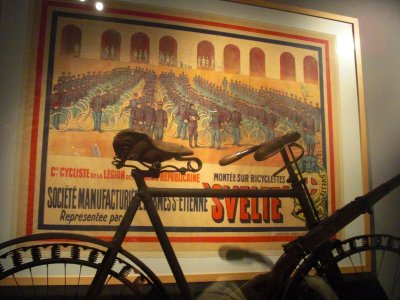 At the right above is an adult tricycle, on which Victorial ladies and gentlemen could go wheeling in the park. Another tricycle model (at the left here, rather blurry) was arranged "sideways"; the rider sat between a huge wheel on one side and a pair of smaller in-line wheels on the other. The two small wheels swiveled independently, and the contraption was steered with a lever on the rider's left that was rigidly attached to the large wheel. The collection also included some prototypes and limited editions, like the superefficient design in which the rider pedals with both hands and feet (ruled ineligible for the Tour de France). Apparently those with disabilities can still get custom bikes pedaled with the hands.
At the right above is an adult tricycle, on which Victorial ladies and gentlemen could go wheeling in the park. Another tricycle model (at the left here, rather blurry) was arranged "sideways"; the rider sat between a huge wheel on one side and a pair of smaller in-line wheels on the other. The two small wheels swiveled independently, and the contraption was steered with a lever on the rider's left that was rigidly attached to the large wheel. The collection also included some prototypes and limited editions, like the superefficient design in which the rider pedals with both hands and feet (ruled ineligible for the Tour de France). Apparently those with disabilities can still get custom bikes pedaled with the hands.
Arms factories also produced bicycles in wartime. About WWI, somebody realized that bicycles were both quieter and lower-maintenance than horses (and ate a lot less). At the right is a depiction of the Republican Guard (France's crack equestrian unit) lined up row on row (in the courtyard of the Invalides, I think) with their bicycles. On the bike you can see part of in the foreground, note the little springs between the inner spoked wheel and the outer, metal wheel rim. I don't know whether that model dates from before the invention of rubber tires or whether rubber just couldn't be spared in wartime, but the rid must have been rough even with the little springs. Oh, and the Republican Guard has since gone back to horses, at least for ceremonial purposes.

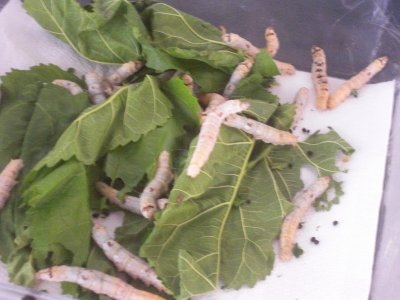 At last I come to Saint-Étienne's third claim to fame, ribbons. A ribbon is defined as a narrow strip of cloth with a selvedge (i.e., a woven edge) on both sides—the guide pointed out that you can't cut a ribbon from a larger piece of cloth; it must be woven to its final width from the beginning. The industry got its start just like that in Lyon, weaving silk for decorative purposes, but narrower. We'd been shown the silkworm life cycle many places during this trip, but the museum actually showed me the worms—they keep a demonstration colony. At the left are a couple of silkmoths busily engaged in making more silkmoths. At the right are some half-grown silkworms, ravenously demolishing a pile of mulberry leaves (we saw teeny-tiny baby silkworms dining on leaves carefully shredded for them, these medium-sized ones, and finally full-grown larvae).
At last I come to Saint-Étienne's third claim to fame, ribbons. A ribbon is defined as a narrow strip of cloth with a selvedge (i.e., a woven edge) on both sides—the guide pointed out that you can't cut a ribbon from a larger piece of cloth; it must be woven to its final width from the beginning. The industry got its start just like that in Lyon, weaving silk for decorative purposes, but narrower. We'd been shown the silkworm life cycle many places during this trip, but the museum actually showed me the worms—they keep a demonstration colony. At the left are a couple of silkmoths busily engaged in making more silkmoths. At the right are some half-grown silkworms, ravenously demolishing a pile of mulberry leaves (we saw teeny-tiny baby silkworms dining on leaves carefully shredded for them, these medium-sized ones, and finally full-grown larvae).
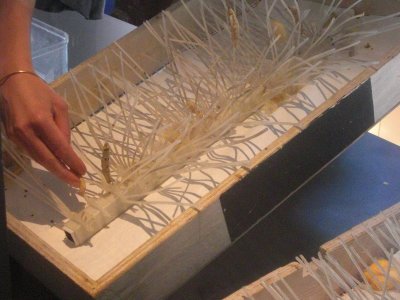
 Some of these largest larvae were ready to pupate, so the guide paused to demonstrate. She plucked several of those she judged mature from the mulberry heap and placed them on this odd plastic apparatus, where, finding themselves on a hard, rigid surface with nothing to eat, they start spinning cocoons. At the right-hand edge of the photo, you can see the edge of another tray with one finished, pale-orange cocoon. In response to my question, she explained that the classic silk moth, Bombyx mori, spins an almost perfectly white cocoon—silk of the highest quality. A closely related species also produces usable silk, but its digestive apparatus is not as capable as that of B. mori of digesting plant pigments, so some of the orange pigments come through into the silk. The museum's colony contains moths of both species and, now, some hybrids, so the cocoons were of a range of colors.
Some of these largest larvae were ready to pupate, so the guide paused to demonstrate. She plucked several of those she judged mature from the mulberry heap and placed them on this odd plastic apparatus, where, finding themselves on a hard, rigid surface with nothing to eat, they start spinning cocoons. At the right-hand edge of the photo, you can see the edge of another tray with one finished, pale-orange cocoon. In response to my question, she explained that the classic silk moth, Bombyx mori, spins an almost perfectly white cocoon—silk of the highest quality. A closely related species also produces usable silk, but its digestive apparatus is not as capable as that of B. mori of digesting plant pigments, so some of the orange pigments come through into the silk. The museum's colony contains moths of both species and, now, some hybrids, so the cocoons were of a range of colors.
At the right, note how a full-size, full-width loom can be set up to weave a number of ribbons at a time. Each ribbon has its own shuttle, which shoots back and forth across just the width of that ribbon on each advance of the Jacquard apparatus, but otherwise, the looms works like any other. Just as with silk cloth, patterns of up to 16 colors can be produced on fully automated industrial looms, but those with more must be done by Jacquard-assistant hand weavers.
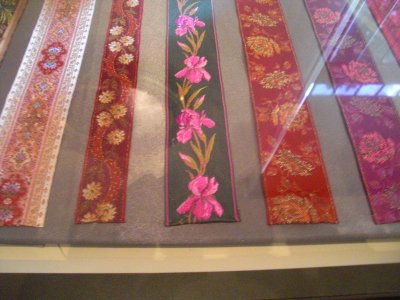
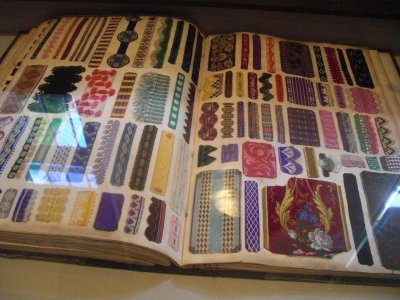 At the left here are some examples of decorative silk ribbons produced in the days when Lyon was still a booming producer of silk fabrics. They would have served as trim for home decorating or on women's clothing.
At the left here are some examples of decorative silk ribbons produced in the days when Lyon was still a booming producer of silk fabrics. They would have served as trim for home decorating or on women's clothing.
At the right is one of dozens, perhaps hundreds, of sample books in the museum's collection. These books would have been shown to prospective commissioners of weaving projects. I saw whole books full of different plaid patterns, other full of florals, others full of zigzags and "eyelet" patterns with woven-in openings in the ribbon.
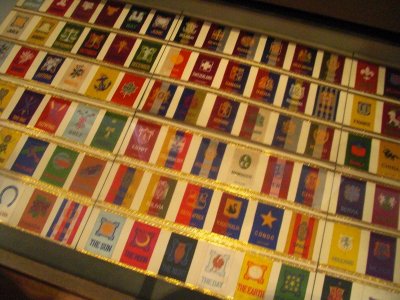
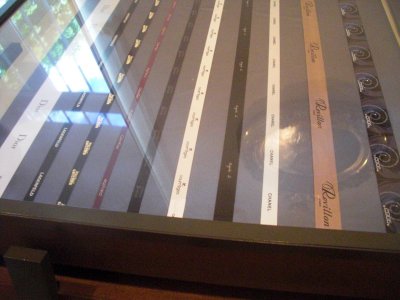 At the left here are "patches, woven in long repeating ribbons, then cut apart. Examples you may have seen in use are scout badges; logos of yacht clubs, or states, or sports teams; and those national-pride ribbons some people hang from their rear-view mirrors. The guide pointed out that every single one of this collection was in English—apparently English-speaking countries use a lot more of this kind of thing than anyone else.
At the left here are "patches, woven in long repeating ribbons, then cut apart. Examples you may have seen in use are scout badges; logos of yacht clubs, or states, or sports teams; and those national-pride ribbons some people hang from their rear-view mirrors. The guide pointed out that every single one of this collection was in English—apparently English-speaking countries use a lot more of this kind of thing than anyone else.
At the right are clothing labels, again woven in long repeating ribbons, then cut apart and sewn into garments (and luggage and other stuff), typically at the back of the neck. This selection includes "Dior," "Chanel," and many other recognizable names.
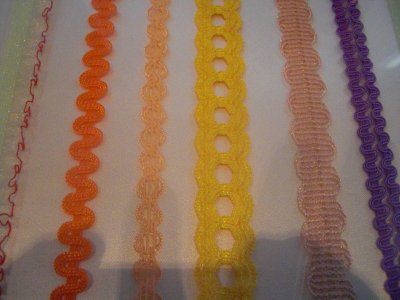
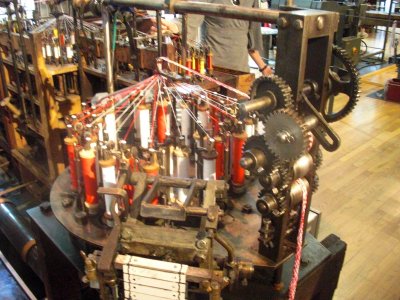 Here are samples of ribbons used as trim in sewing, both familiar rickrack and much less common versions.
Here are samples of ribbons used as trim in sewing, both familiar rickrack and much less common versions.
Finally, at the right is a braiding machine. When it operates, all those vertical bobbins whirl around one another like the planets in an orrery. The finished braid (in this case a tubular cord) comes out the top, crosses to the right, and hangs down the right hand side to the floor. Thank about all those lanyards that hold name-tags at scientific meetings, honor cords at academic commencements, the braided cords you pull to open and close curtains, shoe laces, most nylon rope, and, believe it or not, artificial arteries.
Saint-Étienne is still the world center for the production of ribbons and braids, both handwoven and industrial. If you just think about decorative uses of ribbon on clothing and for wrapping packages, it seems like a pretty narrow niche, but in fact, ribbons are everywhere, and especially since the industry embraced synthetic fibers. Take a look at the handles on your computer bag and canvas tote; the straps on your backpack; the seatbelts in your (and everyone else's) car; ace bandages; the rigging of your window blinds; mountain-climbing gear; the webbing that holds the hooks onto curtains and serves as backing on trouser waistbands; fabric zipper pulls (and the fabric edges of the zipper itself). Everywhere.
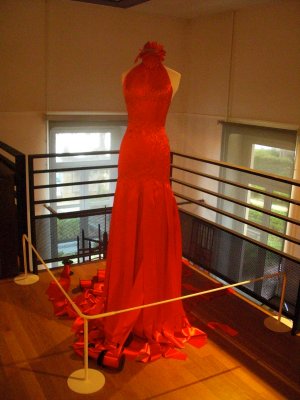
 When the tour was over, I had a few minutes to cast a glance over all the rest of the museum's exhibits, not covered by the guide. Among them was this gorgeous dress made of ribbon. At the right, you can see how the designer put it together with about a million straight pins.
When the tour was over, I had a few minutes to cast a glance over all the rest of the museum's exhibits, not covered by the guide. Among them was this gorgeous dress made of ribbon. At the right, you can see how the designer put it together with about a million straight pins.
But all too soon, it was time to catch the tram back to the train station and the hotel to think about dinner. Everything in Saint-Étienne (or at least everything of enough pretension to advertise) is closed on Sunday. So I had employed my usual strategy and looked up the location of a promising couscous restaurant and a couple of Asian places, figuring we would find a free table at least one of them. Unfortunately, all were across town (near the tram, but still a goodly distance), and David, still bothered by his stomach, didn't feel like going that far. Fortunately, in walking up and down the hill between the hotel and the tourist office, I had spotted a little hole-in-the-wall place called Le Numide (meaning "of or pertaining to Numidia," an ancient Berber kingdom in what is now Algeria and Tunisia) that advertised couscous and, at least at lunchtime, seemed to be a hangout for local north Africans and their little kids. It claimed to be open 7/7, although I had my doubts when I walked by again later, at 3 p.m., to find it closed. But yes, it was open again for dinner, and was only about a block away, so we went there for our supper, and very good it was, too.

 We ordered the "couscous royale," which as usual consisted of a platter of fine, fluffy couscous; a platter of variously roasted, stewed, and grilled chicken, lamb kebab, lamb shoulder, and merguez sausage; and a big bowl of broth full of assorted vegetables and chick peas. Fiery harissa sauce on the side.
We ordered the "couscous royale," which as usual consisted of a platter of fine, fluffy couscous; a platter of variously roasted, stewed, and grilled chicken, lamb kebab, lamb shoulder, and merguez sausage; and a big bowl of broth full of assorted vegetables and chick peas. Fiery harissa sauce on the side.
We dined a little earlier than usual, and from our vantage in the restaurant's front window, we could tell whenever a train pulled into the station a few blocks down the hill to our left, because a few minutes later, a wave of young with backpacks and small rolling suitcases, single or in small groups, would pass us, trekking up the hill toward the middle of town, returning on a Sunday evening, after a weekend away, to the School of Mines or one of Saint-Étienne's other universities. We must have been seeing only a small fraction of the flow, because the tram left from just in front of the station to travel in the same direction by a slightly different route and must have been carrying many more who were returning to lodging farther away.
Eminently satisfactory dinner. Except for one other customer, a single guy, we had the place to ourselves, and chatted later with the owner, who did his best to convince us of the tax advantages of dividing our time between the states and France, in retirement.
previous entry
List of Entries
next entry

 For Sunday, we had planned two of the highlights of our visit to Saint-Étienne, the museum of mines and the city museum. My stomach was a little unsettled at breakfast time, but I took my usual approach to the problem—eat something—and that seemed to help.
For Sunday, we had planned two of the highlights of our visit to Saint-Étienne, the museum of mines and the city museum. My stomach was a little unsettled at breakfast time, but I took my usual approach to the problem—eat something—and that seemed to help.
 At the appointed hour, we and about 20 other people met the guide, as arranged, in the courtyard. He led us through the ramshackle buildings to the pithead (the equipment all seems to work, but absolutely nothing has been done to spruce things up), ensured that each of us chose a hardhat from the racks and adjusted it to fit (one little old lady was so small that she had to select a yellow helmet from the childrens' section; the rest of us got white ones), and took us down in an open cage elevator into the mine. The photo to the right of the tower shows that chamber into which we emerged. The red wall in the background is the elevator door we came out of. Most of my photos seem to have caught sections of wall that are now sheathed in metal or concrete, but farther along the tunnels we came to areas still shored up with timber. Every mine had a large crew of carpenters who did nothing else.
At the appointed hour, we and about 20 other people met the guide, as arranged, in the courtyard. He led us through the ramshackle buildings to the pithead (the equipment all seems to work, but absolutely nothing has been done to spruce things up), ensured that each of us chose a hardhat from the racks and adjusted it to fit (one little old lady was so small that she had to select a yellow helmet from the childrens' section; the rest of us got white ones), and took us down in an open cage elevator into the mine. The photo to the right of the tower shows that chamber into which we emerged. The red wall in the background is the elevator door we came out of. Most of my photos seem to have caught sections of wall that are now sheathed in metal or concrete, but farther along the tunnels we came to areas still shored up with timber. Every mine had a large crew of carpenters who did nothing else.
 The tunnels were "populated" with highly effective black and white cardboard cutouts of the people and horses who worked there. On the right, for example, that is the very machinery that the miner was working on when he was photographed; it's real, but he's a cardboard cutout. The horse is also cardboard, although he's an image of real horse that did actually pass its entire adult life in the mine. Getting a horse into or out of a mine was a very big deal— it couldn't fit in the elevator standing up, so it was slung in some sort of harness (the guide for that portion of the tour was not very clear in her description of the position in which they had to be lowered, but the horses had to be blindfolded so they wouldn't freak out during the process)—so once one was down there, it was normally there for life (although some were occasionally hoisted out if they needed medical attention). Contrary to popular legend, we were assured, the horses did not go blind—if they ever were hoisted out, they still had to be blindfolded—but most live long and healthy lives entirely underground. One, it was said, came to know his job so well that he knew exactly how many trips down the tunnel and back made up a shift and reacted with surprise if asked to do less and great indignation if asked to do more. We visited the underground stable, which still smelled faintly like a stable (I wonder whether the small has really lasted or whether they bring in "used" straw just to maintain that illusion).
The tunnels were "populated" with highly effective black and white cardboard cutouts of the people and horses who worked there. On the right, for example, that is the very machinery that the miner was working on when he was photographed; it's real, but he's a cardboard cutout. The horse is also cardboard, although he's an image of real horse that did actually pass its entire adult life in the mine. Getting a horse into or out of a mine was a very big deal— it couldn't fit in the elevator standing up, so it was slung in some sort of harness (the guide for that portion of the tour was not very clear in her description of the position in which they had to be lowered, but the horses had to be blindfolded so they wouldn't freak out during the process)—so once one was down there, it was normally there for life (although some were occasionally hoisted out if they needed medical attention). Contrary to popular legend, we were assured, the horses did not go blind—if they ever were hoisted out, they still had to be blindfolded—but most live long and healthy lives entirely underground. One, it was said, came to know his job so well that he knew exactly how many trips down the tunnel and back made up a shift and reacted with surprise if asked to do less and great indignation if asked to do more. We visited the underground stable, which still smelled faintly like a stable (I wonder whether the small has really lasted or whether they bring in "used" straw just to maintain that illusion).
 After the underground tour, we visited other areas involved in the operation of the mine. At the left is a photo of the lamp room—each miner checked out a freshly charged lamp at the beginning of his shift and turned it in at the end to be charged (or, in the old days, refilled with oil) overnight. Each miner also carried a numbered token which he hung up in a particular place as he entered the mine and retrieved when he came back out, as a safeguard against anyone's being accidentally left behind in the pit.
After the underground tour, we visited other areas involved in the operation of the mine. At the left is a photo of the lamp room—each miner checked out a freshly charged lamp at the beginning of his shift and turned it in at the end to be charged (or, in the old days, refilled with oil) overnight. Each miner also carried a numbered token which he hung up in a particular place as he entered the mine and retrieved when he came back out, as a safeguard against anyone's being accidentally left behind in the pit.
 Finally, we visited the room everyone else on the tour had heard about (apparently it's a prominent part of the saga of coal mining in France) and waited to see, " la salle des pendus" ("the hall of hanged men"). To give the miners a certain amount of security against having their equipment or personal belongings pilfered by others without devoting the space and materials needed to build actual lockers, the mines hit on this system. Each miner was asigned a pulley with a wire basket for small items and various hooks for clothing, hard hats, shoes, etc. While on duty, he ran his street clothes up to the ceiling and tied off the rope to a cleat below. At the end of the day, he lowered his clothes to change into them and ran his work clothes, boots, and whatnot up in their place. Different people had devised different security measures, like replacing part of the rope with chain and padlocking it to the cleat. (Robert Hessler's lab at Scripps Institution of Oceanography, where David did his graduate work, used a similar system. They had no room on the floor for bicycles, so bike riders hung their bikes from two hooks mounted on a short section of board, ran them up on pulleys to the 14-foot ceilings over their desks, and tied them off to table legs.)
Finally, we visited the room everyone else on the tour had heard about (apparently it's a prominent part of the saga of coal mining in France) and waited to see, " la salle des pendus" ("the hall of hanged men"). To give the miners a certain amount of security against having their equipment or personal belongings pilfered by others without devoting the space and materials needed to build actual lockers, the mines hit on this system. Each miner was asigned a pulley with a wire basket for small items and various hooks for clothing, hard hats, shoes, etc. While on duty, he ran his street clothes up to the ceiling and tied off the rope to a cleat below. At the end of the day, he lowered his clothes to change into them and ran his work clothes, boots, and whatnot up in their place. Different people had devised different security measures, like replacing part of the rope with chain and padlocking it to the cleat. (Robert Hessler's lab at Scripps Institution of Oceanography, where David did his graduate work, used a similar system. They had no room on the floor for bicycles, so bike riders hung their bikes from two hooks mounted on a short section of board, ran them up on pulleys to the 14-foot ceilings over their desks, and tied them off to table legs.)
 In the end, I just walked down to the train station and got us a train-trip type picnic—baguette sandwiches, pastry for me, and cookies for David—which we ate in the room. The train station is famous for the colored tiles with which its exterior is trimmed, and it also featured a couple of modern pieces of monumental art. The best, I thought, was a tree with rectilinear metal trunk and branches hung with large flat plastic oak leaves in what were supposed to be autumn colors. Okay, but not as cool as the flower tree in Lyon.
In the end, I just walked down to the train station and got us a train-trip type picnic—baguette sandwiches, pastry for me, and cookies for David—which we ate in the room. The train station is famous for the colored tiles with which its exterior is trimmed, and it also featured a couple of modern pieces of monumental art. The best, I thought, was a tree with rectilinear metal trunk and branches hung with large flat plastic oak leaves in what were supposed to be autumn colors. Okay, but not as cool as the flower tree in Lyon.
 The museum houses three collections, each representing one of Saint-Étienne's claims to fame: manufacture of weapons, manufacture of bicycles, and manufacture of ribbons and braid. (The fourth, mining, and the fifth and most recent, design, are covered elsewhere.) The guide tour started with the museum of weapons. The first exhibits were of the usual swords and armor (what the French call "armes blanches," i.e., "white arms", as opposed to "armes à feu," i.e., firearms), not made locally but exhibited as a sort of historical lead-in to the firearms, for which the city was long famous. They have hundreds—a few canons, mortars, and whatnot, but mostly hand-held, one-person long guns and some hand guns. The collection was arranged to show the transitions from match lock to flint lock to cap-and-hammer to fire pin and from free-hand muzzle loading to cartridges to breech loading. Saint-Étienne was famous for firearms from their earliest invention, in the days before interchangeable parts, when every gun was individually hand made. For a long time, an enormous factory, up at the northern end of the tramway, where we never got, turned out rifles by the thousands for the military. Today, the best hand-made hunting guns are still made there, by specialists in small workshops. Some of those in the collection, both old and modern, are beautifully engraved and carved.
The museum houses three collections, each representing one of Saint-Étienne's claims to fame: manufacture of weapons, manufacture of bicycles, and manufacture of ribbons and braid. (The fourth, mining, and the fifth and most recent, design, are covered elsewhere.) The guide tour started with the museum of weapons. The first exhibits were of the usual swords and armor (what the French call "armes blanches," i.e., "white arms", as opposed to "armes à feu," i.e., firearms), not made locally but exhibited as a sort of historical lead-in to the firearms, for which the city was long famous. They have hundreds—a few canons, mortars, and whatnot, but mostly hand-held, one-person long guns and some hand guns. The collection was arranged to show the transitions from match lock to flint lock to cap-and-hammer to fire pin and from free-hand muzzle loading to cartridges to breech loading. Saint-Étienne was famous for firearms from their earliest invention, in the days before interchangeable parts, when every gun was individually hand made. For a long time, an enormous factory, up at the northern end of the tramway, where we never got, turned out rifles by the thousands for the military. Today, the best hand-made hunting guns are still made there, by specialists in small workshops. Some of those in the collection, both old and modern, are beautifully engraved and carved. 
 The bicycle section has an amazing variety of early and modern bicycles and their precursers, from early wooden "velocepedes," like modern foot-propelled scooters but with larger wheels and a saddle (you straddled them like bicycles but pushed yourself along with your feet) to the classic "penny-farthing" with the huge front and tiny rear wheels (unsafe at any speed), through the realization that use of a chain meant the pedals didn't have to be on the actual wheel hub and that gears could give you mechanical advantage without a huge wheel, to the earliest geared models (to shift, you had to dismount and move the chain from one sprocket to another) to the actual bicycles used to win a couple of Tours de France.
The bicycle section has an amazing variety of early and modern bicycles and their precursers, from early wooden "velocepedes," like modern foot-propelled scooters but with larger wheels and a saddle (you straddled them like bicycles but pushed yourself along with your feet) to the classic "penny-farthing" with the huge front and tiny rear wheels (unsafe at any speed), through the realization that use of a chain meant the pedals didn't have to be on the actual wheel hub and that gears could give you mechanical advantage without a huge wheel, to the earliest geared models (to shift, you had to dismount and move the chain from one sprocket to another) to the actual bicycles used to win a couple of Tours de France.
 At the right above is an adult tricycle, on which Victorial ladies and gentlemen could go wheeling in the park. Another tricycle model (at the left here, rather blurry) was arranged "sideways"; the rider sat between a huge wheel on one side and a pair of smaller in-line wheels on the other. The two small wheels swiveled independently, and the contraption was steered with a lever on the rider's left that was rigidly attached to the large wheel. The collection also included some prototypes and limited editions, like the superefficient design in which the rider pedals with both hands and feet (ruled ineligible for the Tour de France). Apparently those with disabilities can still get custom bikes pedaled with the hands.
At the right above is an adult tricycle, on which Victorial ladies and gentlemen could go wheeling in the park. Another tricycle model (at the left here, rather blurry) was arranged "sideways"; the rider sat between a huge wheel on one side and a pair of smaller in-line wheels on the other. The two small wheels swiveled independently, and the contraption was steered with a lever on the rider's left that was rigidly attached to the large wheel. The collection also included some prototypes and limited editions, like the superefficient design in which the rider pedals with both hands and feet (ruled ineligible for the Tour de France). Apparently those with disabilities can still get custom bikes pedaled with the hands.
 At last I come to Saint-Étienne's third claim to fame, ribbons. A ribbon is defined as a narrow strip of cloth with a selvedge (i.e., a woven edge) on both sides—the guide pointed out that you can't cut a ribbon from a larger piece of cloth; it must be woven to its final width from the beginning. The industry got its start just like that in Lyon, weaving silk for decorative purposes, but narrower. We'd been shown the silkworm life cycle many places during this trip, but the museum actually showed me the worms—they keep a demonstration colony. At the left are a couple of silkmoths busily engaged in making more silkmoths. At the right are some half-grown silkworms, ravenously demolishing a pile of mulberry leaves (we saw teeny-tiny baby silkworms dining on leaves carefully shredded for them, these medium-sized ones, and finally full-grown larvae).
At last I come to Saint-Étienne's third claim to fame, ribbons. A ribbon is defined as a narrow strip of cloth with a selvedge (i.e., a woven edge) on both sides—the guide pointed out that you can't cut a ribbon from a larger piece of cloth; it must be woven to its final width from the beginning. The industry got its start just like that in Lyon, weaving silk for decorative purposes, but narrower. We'd been shown the silkworm life cycle many places during this trip, but the museum actually showed me the worms—they keep a demonstration colony. At the left are a couple of silkmoths busily engaged in making more silkmoths. At the right are some half-grown silkworms, ravenously demolishing a pile of mulberry leaves (we saw teeny-tiny baby silkworms dining on leaves carefully shredded for them, these medium-sized ones, and finally full-grown larvae).
 Some of these largest larvae were ready to pupate, so the guide paused to demonstrate. She plucked several of those she judged mature from the mulberry heap and placed them on this odd plastic apparatus, where, finding themselves on a hard, rigid surface with nothing to eat, they start spinning cocoons. At the right-hand edge of the photo, you can see the edge of another tray with one finished, pale-orange cocoon. In response to my question, she explained that the classic silk moth, Bombyx mori, spins an almost perfectly white cocoon—silk of the highest quality. A closely related species also produces usable silk, but its digestive apparatus is not as capable as that of B. mori of digesting plant pigments, so some of the orange pigments come through into the silk. The museum's colony contains moths of both species and, now, some hybrids, so the cocoons were of a range of colors.
Some of these largest larvae were ready to pupate, so the guide paused to demonstrate. She plucked several of those she judged mature from the mulberry heap and placed them on this odd plastic apparatus, where, finding themselves on a hard, rigid surface with nothing to eat, they start spinning cocoons. At the right-hand edge of the photo, you can see the edge of another tray with one finished, pale-orange cocoon. In response to my question, she explained that the classic silk moth, Bombyx mori, spins an almost perfectly white cocoon—silk of the highest quality. A closely related species also produces usable silk, but its digestive apparatus is not as capable as that of B. mori of digesting plant pigments, so some of the orange pigments come through into the silk. The museum's colony contains moths of both species and, now, some hybrids, so the cocoons were of a range of colors.
 At the left here are some examples of decorative silk ribbons produced in the days when Lyon was still a booming producer of silk fabrics. They would have served as trim for home decorating or on women's clothing.
At the left here are some examples of decorative silk ribbons produced in the days when Lyon was still a booming producer of silk fabrics. They would have served as trim for home decorating or on women's clothing.
 At the left here are "patches, woven in long repeating ribbons, then cut apart. Examples you may have seen in use are scout badges; logos of yacht clubs, or states, or sports teams; and those national-pride ribbons some people hang from their rear-view mirrors. The guide pointed out that every single one of this collection was in English—apparently English-speaking countries use a lot more of this kind of thing than anyone else.
At the left here are "patches, woven in long repeating ribbons, then cut apart. Examples you may have seen in use are scout badges; logos of yacht clubs, or states, or sports teams; and those national-pride ribbons some people hang from their rear-view mirrors. The guide pointed out that every single one of this collection was in English—apparently English-speaking countries use a lot more of this kind of thing than anyone else.
 Here are samples of ribbons used as trim in sewing, both familiar rickrack and much less common versions.
Here are samples of ribbons used as trim in sewing, both familiar rickrack and much less common versions.
 When the tour was over, I had a few minutes to cast a glance over all the rest of the museum's exhibits, not covered by the guide. Among them was this gorgeous dress made of ribbon. At the right, you can see how the designer put it together with about a million straight pins.
When the tour was over, I had a few minutes to cast a glance over all the rest of the museum's exhibits, not covered by the guide. Among them was this gorgeous dress made of ribbon. At the right, you can see how the designer put it together with about a million straight pins.
 We ordered the "couscous royale," which as usual consisted of a platter of fine, fluffy couscous; a platter of variously roasted, stewed, and grilled chicken, lamb kebab, lamb shoulder, and merguez sausage; and a big bowl of broth full of assorted vegetables and chick peas. Fiery harissa sauce on the side.
We ordered the "couscous royale," which as usual consisted of a platter of fine, fluffy couscous; a platter of variously roasted, stewed, and grilled chicken, lamb kebab, lamb shoulder, and merguez sausage; and a big bowl of broth full of assorted vegetables and chick peas. Fiery harissa sauce on the side.